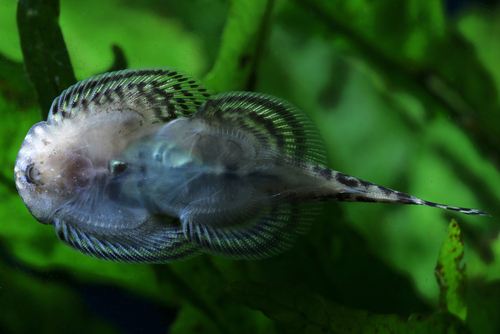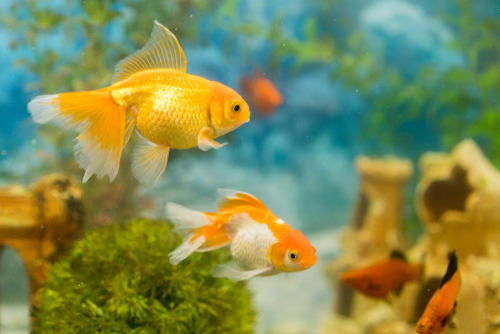Welcome to the fascinating world of Hillstream Loaches, a unique group of freshwater fish often likened to miniature stingrays due to their distinctive physical characteristics.
These peaceful creatures, native to the fast-flowing streams and rivers of Asia, belong to the Balitoridae family, which boasts an impressive 202 species.
Hillstream loaches are renowned for their flat undersides, horizontal fins, and brown colouration adorned with intricate dark brown and white mosaic-like patterns. But their charm extends beyond their striking appearance.
These loaches are perfectly adapted to life in swift currents, possessing streamlined bodies that allow them to cling onto rocks and withstand the force of rushing waters.
Often marketed under names like “lizardfish” or “flossensaugers” in Germany, Hillstream loaches are a captivating addition to any suitable aquarium setup.
Whether you’re considering adding a Hillstream loach to your tank or simply intrigued by these remarkable creatures, you’re in the right place.
Let’s delve deeper into the world of Hillstream loaches, exploring their origins, physical traits, behaviour, and the essentials of providing them with a healthy, thriving environment.
Contents
Physical Characteristics

The hillstream loach is a small fish species with a unique appearance and physical characteristics. In this section, we will explore the hillstream loach’s size, appearance, and unique features.
Size and Appearance
Hillstream loaches are typically small, growing to only 2-3 inches in length. This diminutive size makes them excellent hunters, able to explore tight crevices and access food unavailable to larger fish. Despite their size, they are easily spotted in an aquarium due to their striking appearance.
The hillstream loach has a streamlined shape, smooth body, wing-like pelvic and pectoral fins, and flat underside. The underside of a hillstream loach works as a powerful ventral disc, enabling the fish to “stick” to surfaces in fast-flowing currents and climb vertical surfaces.
Unique Features
Hillstream loaches have unique physical characteristics that make them stand out from other fish species. For example, they have a series of small scales covering their bodies, protecting them from predators.
Another unique feature of hillstream loaches is their barbels. These sensory organs around the mouth help the fish locate food in fast-moving waters. They also have a reticulated pattern on their bodies that helps them blend in with their surroundings.
One type of hillstream loach, the gold ring butterfly sucker, has a distinctive gold band around its body. This band makes it easy to identify and adds to its unique appearance.
Natural Habitat
Hillstream loaches are freshwater fish native to fast-flowing rivers and streams in Southeast Asia, particularly in Vietnam, Laos, Binh Dinh, Quang Ngai, Quang Nam, and Thua Thien-Hue.
They are commonly found in shallow river areas with strong currents, gliding over smooth rocks, and climbing vertical surfaces.
Geographic Distribution
Hillstream loaches are endemic to East Asia and Southeast Asia, with most of the species found in Vietnam. They are also found in Laos, Binh Dinh, Quang Ngai, Quang Nam, and Thua Thien-Hue.
Environmental Conditions
Hillstream loaches thrive in fast-flowing rivers and streams with rocky substrates, where they can attach themselves to the rocks with suction-like mouths.
They require well-oxygenated water with a pH range of 7.0 to 7.8 and a temperature range of 22°C to 26°C. They are sensitive to changes in water quality, so it is essential to maintain a consistent and clean environment.
In their natural habitat, hillstream loaches feed on algae and small invertebrates. They are also known to consume biofilm, a thin layer of microorganisms that forms on the surface of rocks and other substrates in the water.
They are active during the day and rest at night, sheltering in crevices and under rocks.
Aquarium Conditions

When it comes to keeping Hillstream Loaches in an aquarium, it is important to create an environment that mimics their natural habitat. This means paying attention to factors such as tank setup, water parameters, and maintenance.
1. Tank Setup
Hillstream Loaches prefer a well-oxygenated aquarium with a strong water flow. This is because they are native to fast-flowing streams and rivers in Southeast Asia. Therefore, it is important to have a good filter to create enough water movement and provide adequate oxygenation.
Regarding substrate, a combination of sand and gravel can be used to create a natural riverbed look. Driftwood and other decorations can also be added to mimic their natural habitat.
However, it is important to ensure that the decorations do not impede water flow.
2. Water Parameters
Maintaining the right water parameters is crucial to the health and well-being of Hillstream Loaches. The ideal pH range for these fish is between 6.5 and 7.5, with a water hardness of 5 to 12 dGH. It is also important to ensure that the water temperature is between 65°F to 80°F (20°C to 27°C).
It is recommended to use a water testing kit to monitor the water quality regularly. This will help keep the ammonia and nitrite levels at a minimum.
3. Maintenance
Regular maintenance is necessary to keep the aquarium in good condition. This includes performing regular water changes of 10-20% every 1-2 weeks, depending on the aquarium size. It is also important to clean the filter regularly to ensure it functions properly.
Diet and Feeding

Hillstream Loaches are omnivores that require a varied diet to thrive in an aquarium setting. A balanced diet will ensure they receive all the necessary nutrients to maintain their health and vitality.
Natural Diet
In the wild, Hillstream Loaches feed on algae, insect larvae, and other tiny organisms found in their natural habitat. They have adapted to living in fast-flowing streams and rivers, where they can graze on biofilm and other microorganisms that grow on rocks and other surfaces.
Aquarium Diet
Hillstream Loaches should be fed a combination of algae wafers, flakes, pellets, and frozen foods such as brine shrimp in the aquarium. They also enjoy blanched vegetables such as zucchini and spinach, which can be added to their diet occasionally.
It is important to note that Hillstream Loaches cannot survive on algae alone, so it is essential to provide a varied diet. They are bottom feeders and will spend most of their time grazing on the substrate, so sinking foods are recommended.
Hillstream Loaches are also known to eat infusoria, a type of microorganism that grows in the aquarium. This can be beneficial for maintaining a healthy ecosystem in the tank.
Breeding and Lifecycle

Breeding Conditions
Breeding hillstream loaches is not easy, as they require specific conditions to breed. The breeding season for hillstream loaches usually starts in the spring, and it is important to have a separate breeding tank set up for them.
The breeding tank should have a substrate of fine sand or small gravel and be well-aerated with a gentle current.
The water temperature should be around 72°F to 82°F (20°C to 27°C), and the pH level should be neutral to slightly acidic. It is recommended to use a sponge filter to maintain the water quality, as the eggs and fry are sensitive to changes in water parameters.
To encourage breeding, providing the hillstream loaches with a varied diet that includes live or frozen foods is important. It is also recommended to have a male-to-female ratio of 1:2 or 1:3, as males tend to be aggressive during breeding.
Lifecycle Stages
Once the hillstream loaches have mated, the female will lay her eggs in a nest that the male has prepared. The eggs are small and adhesive and will stick to the substrate or rocks in the breeding tank. The male will then guard the eggs until they hatch, which usually takes around 5 to 7 days.
After hatching, the fry will attach themselves to the substrate using a specialised adhesive organ called a “suction disk”. The fry will feed on small organisms such as infusoria and newly hatched brine shrimp.
As they grow, they will start to consume larger foods such as daphnia and small worms.
The juvenile hillstream loaches will take around 8 to 10 months to reach maturity. During this time, it is vital to maintain the water quality and provide them with a varied diet. Hillstream loaches have a lifespan of around 8 to 10 years with proper care.
Breeding and raising hillstream loaches can be a rewarding experience for experienced aquarists willing to provide the necessary conditions and care.
Behaviour and Compatibility
Now, let us look at how these loaches interact by default with their environment.

Behaviour Patterns
Hillstream loaches are peaceful fish that spend most of their time swimming in fast-flowing streams and rivers in their natural habitat. They are omnivores and will eat various foods, including algae.
In the aquarium, they are active and curious fish that enjoy exploring their surroundings. They are known for their ability to “stick to surfaces in fast-flowing currents and climb vertical surfaces.
Hillstream loaches are social fish that thrive in groups of at least three individuals. They are not aggressive towards each other and will often be seen swimming together. They are also compatible with other peaceful fish that share their water parameters and dietary requirements.
Compatible Tank Mates
Regarding tank mates, hillstream loaches are best kept with other peaceful fish that can tolerate fast-flowing water and similar water parameters. Some good options include:
- Snails: Snails are peaceful and can help keep the tank clean by eating algae and other debris.
- Tetras: Many tetra species are peaceful and can add colour and movement to the aquarium.
- Danios: Danios are active and fast-swimming fish compatible with hillstream loaches.
- Catfish: Some catfish species, such as the Corydoras, are peaceful and can help keep the bottom of the tank clean.
- Goldfish: Goldfish are compatible with hillstream loaches if the tank is large enough to accommodate both species and the appropriate water parameters.

It’s important to note that hillstream loaches are incompatible with aggressive or fin-nipping fish. They are also unsuitable for community tanks with slow-moving fish or delicate plants.
Health and Diseases
Hillstream loaches are generally hardy fish and are not prone to diseases if kept in a clean and well-maintained aquarium. However, like all fish, they are susceptible to certain health issues, especially if their water conditions are not optimal.
In this section, we will discuss some common diseases that can affect hillstream loaches and prevention and treatment options.
Common Diseases
Ich
Ich is a common disease affecting many fish types, including hillstream loaches. It is caused by a parasitic protozoan that can be introduced to the aquarium through infected fish or contaminated water. Symptoms of ich include white spots on the fish’s body and fins, lethargy, and loss of appetite.
Fungal Infection
Fungal infections can also affect hillstream loaches, especially if their water conditions are not optimal. Symptoms of fungal infections include white or grey patches on the fish’s body or fins, lethargy, and loss of appetite.
Prevention and Treatment
Preventing disease in hillstream loaches is largely a matter of maintaining good water quality and providing a healthy environment. This includes regular water changes, proper filtration, and adequate oxygenation.
If your hillstream loach becomes sick, several treatment options are available. For ich, several medications can be added to the aquarium water to kill the parasites. For fungal infections, antifungal medications can be used to treat the fish.
It is important to note that prevention is always better than treatment when it comes to fish health. By maintaining good water quality and providing a healthy environment, you can help ensure that your hillstream loaches stay healthy and disease-free.
Conservation Status

The reticulated hillstream loach, also known as Sewellia lineolata, is listed as “Vulnerable” on the IUCN Red List due to a decline of at least 30% between the years 2000 and 2010.
The main threats to this loach are runoff from deforestation, habitat destruction due to dam building, and over-fishing.
In their natural habitat, hillstream loaches live in the fast-flowing rivers of Vietnam, including Quang Nam, Thua Thien Hue, Laos, Binh Dinh, and Quang Ngai. Unfortunately, these rivers are under threat due to human activities such as deforestation, dam building, and over-fishing.
The loss of habitat due to deforestation and dam building significantly impacts the hillstream loach population. The construction of dams can alter the flow of rivers, making it difficult for loaches to swim upstream to spawn.
In addition, the runoff from deforestation can cause water pollution, which can harm the loaches’ health.
Over-fishing is also a significant threat to the hillstream loach population. These fish are caught for food, aquarium trade, and traditional medicine. Over-fishing can lead to a decline in the population, which can significantly impact the ecosystem.
Efforts are being made to conserve the hillstream loach population. The IUCN Red List has listed them as “Vulnerable,” meaning they risk becoming endangered if conservation measures are not taken. Some measures that can help conserve the hillstream loach population include:
- Protecting their natural habitat from deforestation and dam building
- Regulating fishing to prevent over-fishing
- Raising awareness about the importance of these fish in the ecosystem
- Breeding hillstream loaches in captivity to reduce the demand for wild-caught fish.
Hillstream Loach Care
Hillstream loaches are unique freshwater fish that require specific care to thrive in a home aquarium. Here are some important considerations for keeping hillstream loaches healthy and happy:
1. Tank Size

Hillstream loaches are active swimmers that require a lot of space to move around. A minimum tank size of 20 (80L) gallons is recommended for a small group of hillstream loaches. However, larger tanks are always better for these fish as they need plenty of swimming space.
2. Water Parameters
Hillstream loaches prefer fast-flowing water with high oxygen levels. A good water flow rate is 10-15 times the tank volume per hour. The ideal temperature range for hillstream loaches is between 68-78°F (20°C to 27°C). pH levels should be between 7.0-7.8, and water hardness should be between 5-15 dGH.
3. Hiding Spots
Hillstream loaches are naturally shy fish that require plenty of hiding spots to feel secure. Rocks, caves, and driftwood are great options for creating hiding spots in the aquarium. Be sure to provide plenty of hiding spots, especially if you have a group of hillstream loaches.
4. Diet
Hillstream loaches are omnivores that require a varied diet. They will eat algae, small invertebrates, and fish flakes or pellets. Be sure to provide a mix of these foods to ensure a well-rounded diet.
5. Tank Mates
Hillstream loaches are peaceful fish that can be kept with other non-aggressive species. Good tank mates include other peaceful fish such as tetras, rasboras, and corydoras. Avoid keeping hillstream loaches with aggressive or territorial fish, as they may become stressed or injured.
Additional Research
Research on hillstream loaches, including Sewellia lineolata, tiger hillstream loach, and reticulated hillstream loaches, is ongoing.
Scientists are interested in understanding the genetic basis of the specialized morphological features of these fish, such as their flattened ventrum and craniofacial and body skeletons, as well as their ability to walk on land.
Some studies have suggested that at least 11 species of fish within the hillstream loach family may have land-walking abilities.
Temperature range is another area of interest for researchers studying hillstream loaches. These fish are adapted to live in fast-flowing streams with cool, well-oxygenated water.
In the wild, they are found in mountain streams in Asia, where water temperatures can range from 18°C to 30°C. Studies have shown that hillstream loaches can adapt to a range of temperatures in the freshwater aquarium, but they prefer cooler water with a pH of around 7.8.
Additional research is needed to understand better the behaviour and habitat requirements of hillstream loaches in the wild. This information can help aquarium hobbyists provide the best care for these captivity fish.
Researchers are also investigating the potential medicinal properties of compounds found in hillstream loaches, such as their antimicrobial peptides.
Frequently Asked Questions
What is the ideal number of hillstream loaches to keep together?
Hillstream loaches are social creatures and thrive in groups. Keeping a group of at least three or more loaches in a tank is recommended. However, it is important to ensure that the tank size is appropriate for the number of loaches.
What is the minimum tank size required for hillstream loaches?
Hillstream loaches require a tank that is at least 20 gallons (80L) in size. It is important to note that the tank size should increase with the number of loaches in the tank. A larger tank will also provide more swimming space and a more natural environment for the loaches.
How many hillstream loaches can be kept in a 20-gallon tank?
A 20-gallon (80L) tank is suitable for up to three hillstream loaches. It is crucial to ensure that the tank is well-filtered and has enough hiding places and swimming space for the loaches.
What is the maximum size that hillstream loaches can reach?
Hillstream loaches typically grow to a size of 2 to 4 inches in length. However, some species can grow up to 6 inches in length. It is essential to research the specific species of hillstream loach to determine their maximum size.
What are some compatible tank mates for hillstream loaches?
Hillstream loaches are peaceful fish and can coexist with various tank mates. Some compatible tank mates for hillstream loaches include small tetras, rasboras, and guppies. It is important to avoid keeping aggressive or territorial fish with hillstream loaches.
What is the lifespan of hillstream loaches in captivity?
Hillstream loaches can live for up to 5 years in captivity with proper care. It is important to provide a well-maintained tank with appropriate water conditions and a balanced diet to ensure the longevity of the loaches.
Key Takeaways
- Hillstream loaches are small, peaceful freshwater fish native to fast-moving streams and rivers in Asia.
- They have streamlined bodies built to grip tightly onto rocks and withstand rushing rapids.
- Hillstream loaches can make great additions to the right aquarium setup.
You will also like these other popular posts:

Veteran fish keeper and keen hobbyist with a serious case of MTS. My midlife crisis was the establishment of a fish room, much to my wife’s horror. Little does she know it could be worse!!


